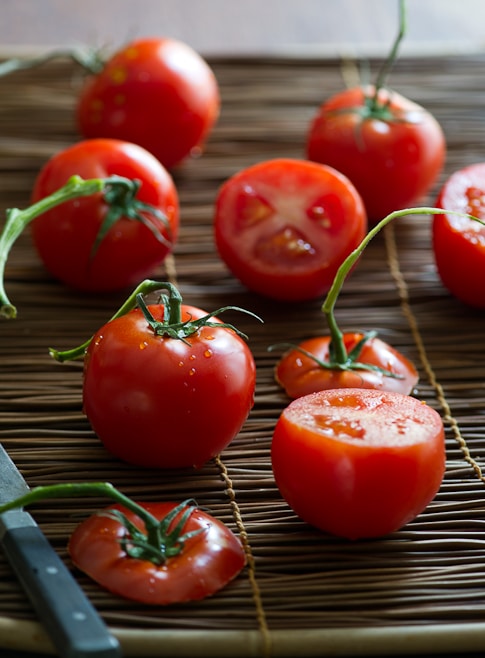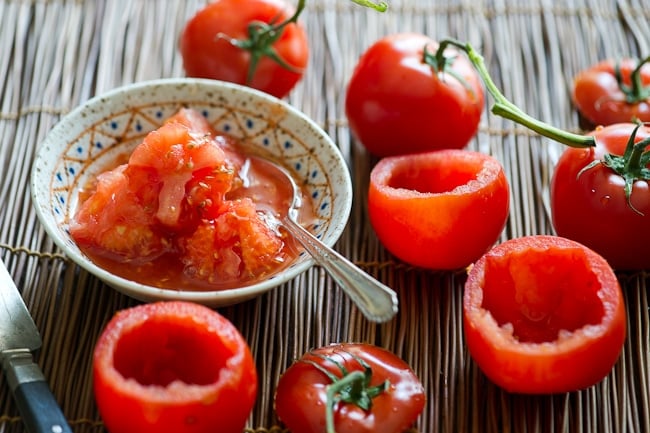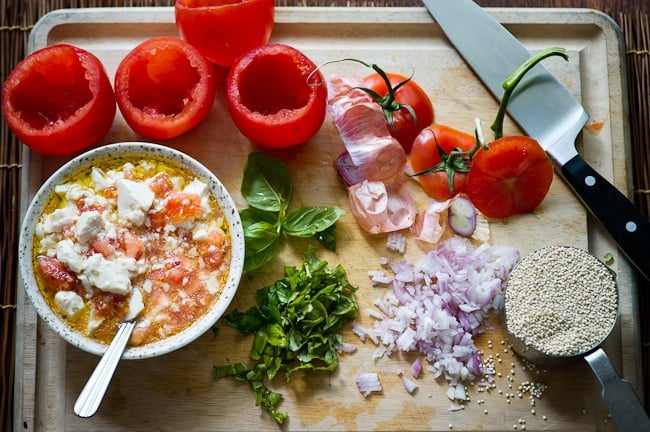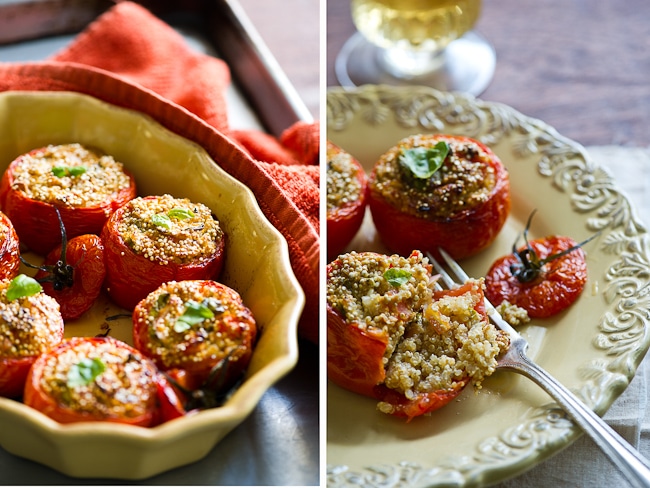The sun has been very kind to us over the last week. We had two fabulously warm days to dry out all the dampness that late Winter left behind. Indeed, we’re very lucky to be living in warm Southern California weather where our garden basil is looking fantastic and we are getting some early season tomatoes at the market. And somehow, we got our hands on Heidi Swanson’s new Super Natural Everyday cookbook.
Honestly, today’s post isn’t meant to make anyone envious. We just kinda won the weather, produce & cookbook lottery!
We’ve been nurturing some tender baby basil plants and even this early in the season, it’s never too early to pick a few leaves and indulge in what Summer will soon offer.
It must be from all the vitamin E we’ve been getting from the sun because when ever the warmth arrives, we’re craving tomatoes, basil and whole grains. How perfectly planned was it to have Heidi’s book with a stuffed tomato recipe waiting with our name on it? It’s stuffed tomato karma, that’s what it is.
Heidi’s latest kitchen labor of love is certainly felt in Super Natural Every Day. It’s a gorgeous book that feels so honest and real for her love of natural foods.
Without a doubt, every recipe is sure to be a winner. Each page is filled with her amazing images and nourishing recipes. You don’t even miss the meat when you look at her graceful textures of ingredients and grains. The focus on fresh produce and perfectly spiced flavors sings from every page. Besides, we all should get back to eating more whole grains and vegetables every day. We’ll all feel super natural together!
 In Super Natural Every Day Heidi developed a terrific stuffed tomato recipe with couscous. It was hard not for us to not immediately dive into making it. Without looking to see if had all the ingredients available, we started picking some basil from the garden and began the recipe. But shame on us for not checking the list because we didn’t have most of the main ingredients in the recipe.
In Super Natural Every Day Heidi developed a terrific stuffed tomato recipe with couscous. It was hard not for us to not immediately dive into making it. Without looking to see if had all the ingredients available, we started picking some basil from the garden and began the recipe. But shame on us for not checking the list because we didn’t have most of the main ingredients in the recipe.So instead, we improvised with what we had in our pantry. Heidi’s original list calls for couscous, yogurt and harissa. We didn’t have any of those, so instead we replaced them with quinoa, soft tofu and homemade hot sauce.
The stuffed tomatoes turned out perfectly! The recipe was quite easy to adapt to what ingredients we had on hand and we were so pleased with the results. The tofu added extra protein, and the quinoa gave a satisfying bite, not to mention the great crunch of the top layer of quinoa.
Like we mentioned, we’re not wanting all you cold weather friends to be jealous because we’re certainly envious of all your great snow. But hopefully this recipe will give you something to celebrate in a month or so when your weather brings warmer sunshine, tomatoes and basil.
Enjoy,
Diane
 Print This Recipe
Print This Recipe Stuffed Tomatoes with Quinoa, Soft Tofu, basil, shallots
adapted from 101 cookbooks, Super Natural Every Day
adapted from 101 cookbooks, Super Natural Every Day
We substituted the original whole wheat couscous in the recipe with quinoa, which still turned out great. The quinoa on the top layer of the tomatoes became a nice crunchy texture. **The size of the tomatoes will greatly vary the cooking times and how long it will take the quinoa to be fully cooked in the center of the tomatoes. Continue checking the middle of the tomtoes to ensure that the quinoa is cooked.
We also substituted soft tofu instead of yogurt and hot sauce instead of harissa from the original recipe.
Ingredients:
- 6 medium-large, ripe red Tomatoes. Each tomato should average about 5 ounces each.
- 1/2 cup of silky soft Tofu
- 1 tablespoon of Hot Sauce, to your preferred taste
- 1 tablespoons of extra virgin Olive Oil, plus a little to drizzle
- about 12 fresh Basil leaves, chopped
- 2 shallots, minced
- 1 teaspoon Soy Sauce
- 1 Garlic Clove, finely minced
- 1/2 cup of Couscous or Quinoa
- sea salt and fresh cracked black pepper to taste
2. Carefully, using a serrated knife, cut the tops of each tomato, allowing enough room for you to spoon in the mixture. Work over a large bowl, scoop out the flesh of each tomato. If needed, break up any large chunks of the tomato flesh. Arrange the hollowed out tomato shells in the greased baking dish. Lightly brush the outside of the tomatoes with a bit of olive oil.
3. For the filling, combine 2/3 cup of the tomato flesh & juice, tofu, hot sauce, olive oil, most of the basil, shallots, soy sauce, salt, black pepper and garlic in a bowl. Add the quinoa and stir until all ingredients are combined. Adjust the filling to your acquired taste with salt and pepper. Using a spoon, fill the stuffing in the tomatoes till the tomatoes are almost full.
4. Bake the tomatoes for about 50-60 minutes, or until the quinoa is cooked. The tomatoes will start to wrinkle and brown. If this happens before the quinoa is fully cooked, then cover the tomatoes with aluminum foil and continue cooking the tomatoes until the filling is full cooked. The top layer of quinoa on the tomatoes will be slightly crunchy.
5. Drizzle with a bit of olive oil and remainder of the basil. Serve warm. Serves about 6.









